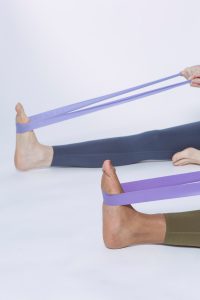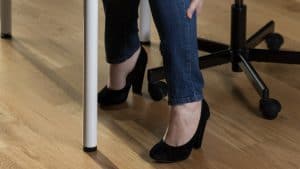Many of us don’t even know what the correct posture is for sitting. We practice poor posture by default in our daily dealings. The only thing most people will know is that you are supposed to keep your back straight. A bad posture can create a lot of problems.
To begin with, you will start getting tired, and fatigue will creep into your body, this will often lead to you adopting poor posture. You will feel knots in your muscles, followed by muscle pain. This can turn into problems for a long period where even a tiny movement can shoot a spasm of pain in the problem area.
One of the common tell-tale signs is slouching. If you keep slouching for long, your body can change in shape. Your shoulder blades will push out while your shoulders cave in and slump, your chest and stomach will cave in. This can even put a strain on your internal organs.
Your looks are affected as well. Your body language suffers too. All these things can put a damper on your confidence. Slouching carries on when standing as well. It is mostly because of our heavy bags with laptops. You should get a bag with a dedicated laptop pouch, which stays flush against your back. Your straps should be adjusted in a way that they do not pull your shoulders back or do not push into you.
We don’t anyway assume correct posture when sitting or standing; it doesn’t matter if you have a state-of-art ergonomic chair. If you don’t sit right, no amount of help is going to be enough.
Here are some of the bad sitting practices that are common for a lot of us –
- Sitting cross-legged in your chair or sofa.
- Craning your neck forward to work on the computer.
- Sitting in a slumped/slouched position.
All of these positions do not promote spine health. Instead, they build up uneven tension in your body. These positions also restrict blood flow. All of these things lead to back pain, neck pain, and over time they can turn into muscular diseases.
Cleveland Clinic talks about the correct postures to stand, walk, sit, and lie. You can read it to know more about the correct ways to hold your postures for different activities, including driving.
When we’re tired, we have the tendency to slouch, this leads to misalignment of shoulders and spine, and this can end up causing you back and neck pain. Your lower back usually suffers the most with a wrong sitting posture.
Most of our work nowadays involve sitting in a chair for 8-9 hours, and for people who like burning the midnight oil, the hours stretch more. It is very important to take breaks often to stand and stretch so that you can bring some relief to your tensed out muscles. Not many people follow it, though, unless the pain becomes too noticeable.
The Correct Sitting Position to Avoid Pain

With our 9-to-5s, we stay sitting for a good part of our days. It is even worse if you are an entrepreneur or start-up founder – this means spending a good part of 14 to 16 hours working. Not everyone invests in ergonomic chairs, and not many know about ergonomics to begin with.
People who work from home suffer the most because they do not have a dedicated workspace usually. Working on beds and sofas, without proper back support, can be more disastrous for you than working in an average office chair.
The least you can do is learn about the correct sitting position if you sit for prolonged hours. Research and invest in a good ergonomic chair so that you get the support and comfort you deserve.
Back

Your back should be parallel to the backrest and be supported at all times. If you suffer from lower back pain, you might need to pay more attention to the lumbar support. You can add an extra pillow to increase the comfort and support for your lumbar area.
Arms

Next, your arms are always strained when working on the keyboard. To avoid pain, your arms should be bent at an angle that is between 75 to 90 degrees when resting on the armrest of the chair. This is why it is important to have an ergonomic chair with adjustable features so that you can customize the chair to accommodate your needs.
Feet

Keep your feet firmly planted on the ground to take some strain off of your thighs and knees. While dangling your legs might seem fun, it isn’t when you have to sit for hours. Neither is having to hug your knees because the area between the seat and the floor is too less.
This is why you have to choose a chair with the correct height or one with an adjustable height. If you already have a great chair with just the issue of your feet not reaching the floor, you can add a footrest to remedy that.
Thighs

The same reason as the feet one, the same solution as well. To know if you have the correct seat height, make sure your thighs are parallel to the floor when you plant your feet on the floor. This means that you have the correct height.
Knees

Your knees should be positioned even with your hips and should stay at a 90-degree angle or sit a little higher than your hips so that there is no strain on them. When sitting, pull your shoulders back, because when you slouch, your body automatically pulls your legs back to support you and avoid falling over.
How to Correct the Posture
Don’t Be a Slouch

Slouching often occurs when we are tired. We tend to lean forward to relieve the pressure on our lower back, but this ends up adding more stress on our spine. Slouching puts a strain on your bones, muscles, and your joints that hold your backbone in place.
Slouching is not only bad for your back health, but it can also, over time, cause more health issues. Slouching makes our internal organs smash together. Chances are you have seen someone slouch so much that their stomach seems to have been sucked in, and they can’t even straighten their back completely even if they try.
This can make it difficult for your lungs and intestines to work. That can make it hard to get enough air when you breathe and also difficult to digest food.
Sit Straight

Slumping at the desk is unavoidable during long hours of work, as mentioned before. But, to hold proper posture, you have to make sure to avoid doing it. You have to let go of your poor posture habits and sit straight.
To do that, sit all the way back in your chair, with the back of the chair supporting your back. Place a lumbar cushion to support your mid-back and to protect the natural curve of your spine.
And as talked about in the earlier section, keep your feet flat on the floor and your knees at the same height or a little higher than your hips to achieve better posture.
How to Check if Your Slouching is Permanently Damaging
You will know if you are slouching or not. Shoulder muscle knots are an easy tell for yourself too. If you slouch for hours, you can tell by the pain points in your shoulder and your neck. What you need to find out is whether you are spending most of your time in that position, because long periods of holding the position can shape your body in that way. Here’s how to tell if permanent damage is taking place:
- Stand against a wall and place your head against the wall.
- Place your feet 6 inches away from the wall.
When standing in this position, your butt should touch the wall, and your lower back and neck should be about 2 inches away from the wall. If this is not the case, then your body shape is falling prey to your bad posture habits. You might want to take immediate steps to fix your posture. You can talk to your doctor about it to get the correct way to improve your posture.
How to Fix Posture With Exercise
One of the effective ways of correcting posture is by exercising. There are exercises designed for posture correction. Here are some of the easy ones to start you off with to achieve better posture:
1. Plank
I know planks aren’t the most fun thing to do, but they get the job done. We will be talking about two types of planks here:
High Plank

The high plank helps with:
- Relieving pain and stiffness throughout the body
- Strengthening shoulders
- Strengthening glutes and hamstrings
- Strengthening core and back
- Developing balance
How to do a high plank:
- Take a push-up pose by being on your fours with your legs straight. (You balance your leg on your toes and raise your hips)
- Your back should be straight.
- Engage your abdominal muscles and your arm and leg muscles.
- Look down at the floor by lengthening your neck and softening the tension in your throat.
- Your shoulder should be back, and your chest should be open. (This is achieved by proper placement of your arms)
- Hold this pose for up to 1 minute at a time. When starting out, you can do it for even smaller intervals.
Side plank

The side plank helps with:
- Maintaining the natural alignment of the spine and legs
- Working out your side and glute muscles
- Strengthening your side and glute muscles and also aligning them to support your back better
How to do a side plank:
- Take a normal plank position, and bring your left hand slightly towards the center.
- Shift your weight onto your left hand.
- Lift your hips and knees and stack your ankles so that your body weight completely rests on one side.
- When beginning, you can rest your knees on the floor for extra support.
- Either place your right hand on your hip, or extend it toward the ceiling. (This helps you balance better when on one side)
- Engage your abdominal muscles and side body and glute muscles.
- Your body should be in a straight line from head to toe when maintaining this pose.
- Look straight ahead so that your head is aligned as well.
- Hold this pose for 30 seconds and then switch sides.
2. Downward-Facing Dog
Everyone who has even thought of doing yoga or never even considered doing yoga has heard of this pose. It is one of the most popular poses that people know about, and it also helps in correcting poor posture.

The downward-facing dog helps with:
- Balancing out your body
- Relieving back pain
- Strengthening back muscles
- Aligning back muscles
How to do a downward-facing dog:
- Lie on your stomach, to begin with.
- Press into your hands and start lifting your knees and hips toward the ceiling while tucking your toes under your feet so that your feet are planted on the floor with your heels slightly risen.
- Bend your knees slightly so that you can lengthen your spine.
- To know if you are in the right position, check to see if your ears are in line with your upper arm and also tuck your chin into your chest all the way.
- Keep your heels lifted slightly and keep your hands planted firmly on the floor.
- Hold the position.
3. Forward fold
Forward fold is a standing stretch exercise that focuses on releasing tension and stretching of all the problem areas.

The forward fold helps with:
- Releasing tension in your spine
- Releasing tension in your glutes and hamstrings
- Stretching your hips and legs
- Opening up and lengthening your back
How to do a forward fold:
- Stand straight with your big toes touching. Place your heels slightly apart.
- Bring your hand to your hips.
- Fold forward at your hips.
- Release your hand and stretch as far as your hands go. You can either place them on the floor, on the blocks or place them on your legs – wrapped around the ankle for support.
- Bend your knees slightly and soften your hip joints by releasing tension.
- Allow your spine to lengthen.
- Tuck your chin into your chest.
- Let your head hang heavy toward the floor.
- Hold the pose for up to 1-minute.
4. Chest opener
Slouching can make your chest cave in. When you slouch for long, your chest tends to move inward. This exercise helps you to correct your posture so that you can stand up or sit straighter.
The chest opener helps with:
- Opening and stretching your chest
- Strengthening your chest
How to do a chest opener:
- Stand with your feet spread wide. (Hip-width apart)
- Keep your body in one line, as straight as you can, as you gaze straight ahead of you. Your head, neck, and spine should form a line.
- Bring your arms back so that you can press your palms together while your fingers are interlaced. (If your hands don’t reach each other, you can hold a towel)
- Inhale as you bring your hands back and lift your chest toward the ceiling.
- Exhale while you bring your hands back toward the floor.
- Repeat for at least 10 times.
5. Child’s pose
This is one of the easiest poses to do on this list because it doesn’t put much strain on you but does help you in many ways.

The child’s pose helps with:
- Stretching and lengthening your spine
- Stretching and lengthening your glutes and hamstrings
- Releasing tension in your lower back and neck
How to do a child’s pose:
- Sit on your shin bones while your knees are pressed together.
- Your heels should be splayed out to the side while your big toes are touching.
- Fold forward at your hips so that your stomach and chest are resting on your thighs and knees.
- Lengthen your arms and place your palms flat on the floor.
- Your hips should rest on your legs toward your feet. (If you have a problem doing that, you can place a pillow under your thighs for support)
- Now place your head on the floor and turn your head on one side.
- Breath deeply, let it feel in the back of your rib cage and waist.
- Relax and hold this pose for up to 5 minutes.
- Continue to breathe deeply while holding the pose.
Conclusion
Having proper posture is more important for the health of your body than it is for looking good. Having a good posture will help you stay strong, flexible, and be balanced. It also makes you seem confident and helps you give off positive energy.
Your body language is often dependent on the posture. If you are used to slouching, it can make you seem underconfident and timid. Bad posture not only affects the way people see you, but it also leads to muscle pain, muscle and ligament stress, and less energy.
Follow the proper positioning of your body to promote good posture and spine health. Use the exercises mentioned in the above section to fix your posture. Posture enhancing exercises are often focused on releasing stress and tension from your muscles and strengthening and lengthening your body. All of this is necessary to keep your body in good shape and better health.
Also, if you work hours on end on a desk, then it is a good idea to invest in an ergonomic chair. You owe yourself the comfort and support to keep going as strongly as you can. I have a lot of tips on buying the best chair based on different needs and different budgets. Take a look around; I am sure you will find something that can be of help.






